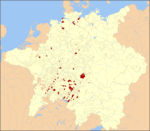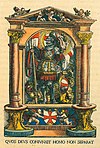Free Imperial City of Ulm
Free Imperial City of Ulm Freie Reichsstadt Ulm | |||||||||
|---|---|---|---|---|---|---|---|---|---|
| 1181–1803 | |||||||||
Mediatised to Bavaria | 1803 | ||||||||
• Annexed by Württemberg | 1809 | ||||||||
| |||||||||
The Free Imperial City of Ulm was a
Free Imperial City of the Holy Roman Empire. It is situated on the left bank of the Danube, in a fertile plain at the foot of the Swabian Jura.[1]
History
Protestant in 1530 and declined after the French Wars of Religion of the 16th century and 17th century. In 1802 it lost its Imperial immediacy and passed to Electorate of Bavaria, being ceded to Kingdom of Württemberg in 1810. In October 1805 General Karl Mack von Leiberich and his 23,000 Austrian troops capitulated to Napoleon here. Ulm is remarkable in the history of German literature as the spot where the Meistersingers lingered longest, orally preserving the traditional folklore of their craft.[2]
References
- ^ Ulm. 2012. Encyclopædia Britannica Online. Retrieved 19 June 2012, from http://www.britannica.com/EBchecked/topic/613251/Ulm
- ^ a b c d e f Chisholm, Hugh, ed. (1911). . Encyclopædia Britannica. Vol. 27 (11th ed.). Cambridge University Press. p. 567.





